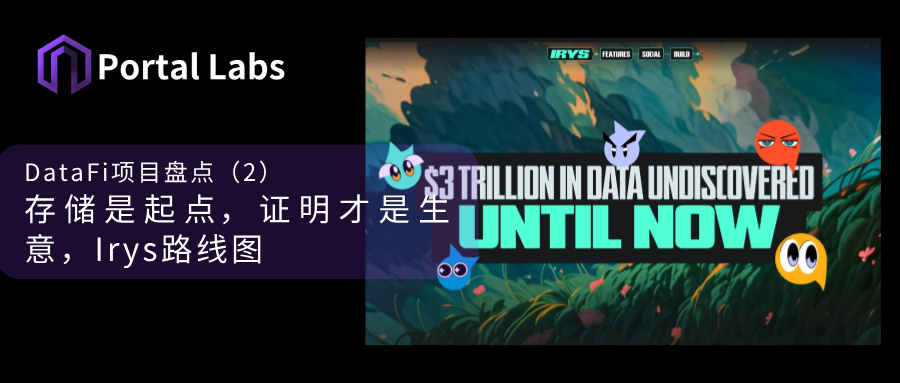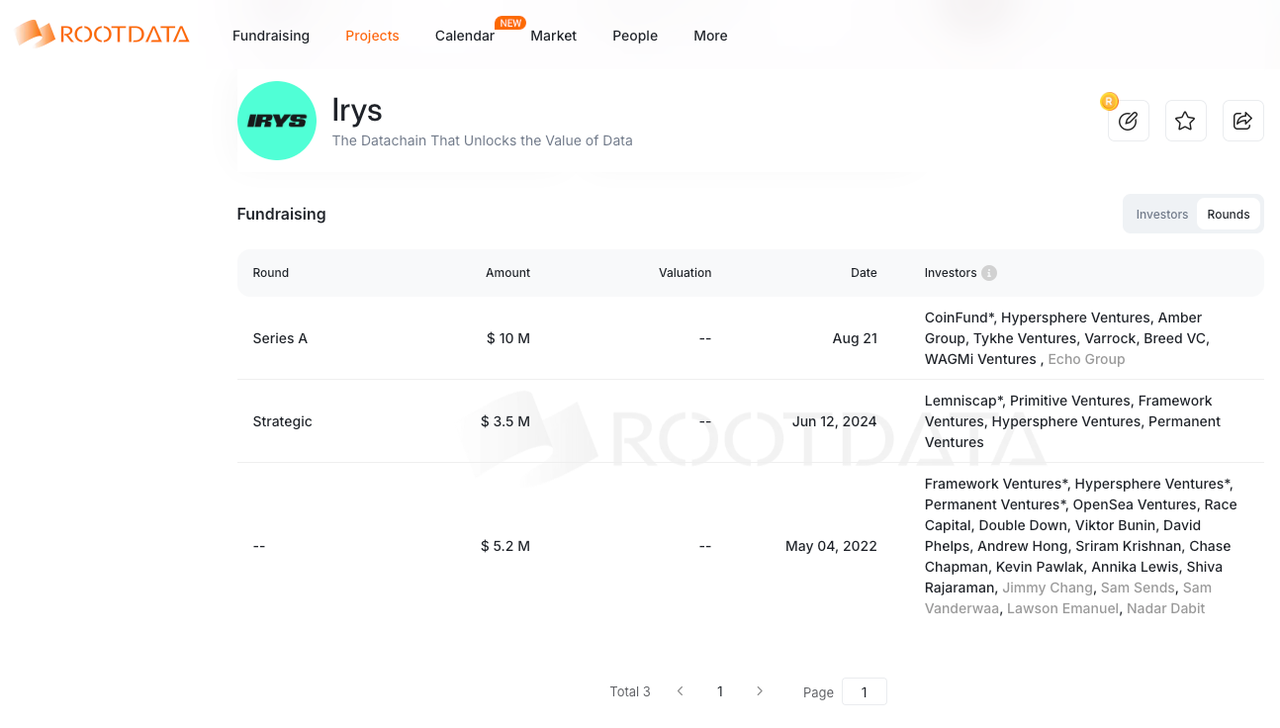
In the article "DataFi Project Review: From Mechanisms to Implementation, Who is Building a New Order in Data Finance? (Part One)," Portal Labs first conducted research around the DataFi track and the OpenLedger project, attempting to outline the basic mechanisms and early implementation directions of the track. Considering the complexity of project paths and technical logic, Portal Labs will subsequently conduct a series of studies and analyses on representative projects.
If the story of OpenLedger revolves around building a DataFi business model based on AI, then Irys extends another set of business logic based on storage.
In last week's article "Web3 Data Divided into Three: Storage, Analysis, and Assetization, Which is the Ultimate Path?" we summarized three paths in the Web3 data track: storage, analysis, and assetization, and judged that assetization will be a key direction for future business models. Irys happens to be at the intersection of this logic: starting from storage, it is attempting to move towards data assetization.
About Irys
The story of Irys begins with Bundlr Network. As a scaling tool within the Arweave ecosystem, Bundlr's early positioning was quite singular, taking on the task of transaction packaging and high throughput on-chain, allowing Arweave to operate faster and cheaper. And it indeed performed well, helping Arweave achieve over 1 billion transactions. However, as the scale of data expanded, Bundlr gradually accumulated independent value and chose to rebrand as Irys in 2023.

Irys proposed the vision of a "Credibility Ledger," emphasizing that data can not only be stored but also self-verify its source and reliability, attempting to move beyond the "tool" positioning towards an independent programmable data chain.

The financing path also reflects this transformation: In June 2024, Irys completed a new round of financing led by Lemniscap; on August 21, 2025, it completed a $10 million Series A round led by CoinFund, accumulating nearly $20 million in financing. Both Lemniscap and CoinFund are known for their focus on infrastructure and new narratives. This also shows the market's expectation for Irys as the "DataFi data foundation."
The core of Irys's shift lies in its redefinition of data—not merely as "archiving," but as elements that can be called upon and orchestrated. Irys draws on the development logic of the internet, pointing out that the early internet was limited to static pages, and true prosperity came from the application ecosystem released by programmability. Similarly, in the on-chain world, if data is only stored in isolation, its value is limited; only when data can flow, trigger logic, and be embedded in applications does it truly become a productive resource.
In Irys's narrative, the significance of the "programmable data chain" is to make data an active element at the application layer. Compared to traditional storage protocols, it emphasizes three key differences:
Credibility proof. Data on-chain is accompanied by verifiable sources and integrity.
Programmability. Through the virtual machine interface (IrysVM), data can directly drive contract logic.
Long-term availability. Under a multi-ledger structure, it retains permanent storage while also providing flexible terms, reducing cost burdens.
For this reason, Irys aims to position itself in a new coordinate system—distinct from networks like Arweave and Filecoin that focus on "storage," and different from solutions like Celestia and EigenDA that target "availability," existing as a foundational facility for "integrated storage and execution."
To achieve this positioning, the core features of Irys's product design are mainly reflected in three aspects:
First, multi-ledger architecture. Data does not directly enter permanent storage at the outset; instead, it is first written to the Submit Ledger for verification and replication, then enters the Publish Ledger for long-term preservation. In the future, a Term Ledger will be introduced, allowing developers and enterprises to choose storage by duration. This layered structure reduces costs while allowing different types of data to find suitable homes.
Second, IrysVM. Through a set of EVM-compatible virtual machines, developers can directly read, orchestrate, and write back data on-chain. This way, data is no longer a "passively existing" archive but can directly drive contract logic, becoming input at the application layer. In other words, Irys enables stored data to possess "programmability."
Third, consensus and incentive mechanisms. Irys adopts a combination of uPoW (useful Proof of Work) and Staking. Nodes must not only pledge storage space (with 16TB as the basic unit) but also continuously submit proofs of storage integrity. Nodes that fail to meet the requirements will be penalized, while qualified nodes will be rewarded. This mechanism ensures long-term availability and enhances the credibility of the data.
Around these designs, Irys provides SDK, CLI, and Gateway services for development interfaces, supports multi-currency payments (ETH, USDC, SOL, etc.), and offers variable references and folder organization features, reducing the complexity of developer integration. Overall, its product logic is: starting from storage, gradually transitioning to data invocation and execution, making data a "first-class citizen" on the chain.
Business Model
If product design explains how Irys operates, then the business model determines how it captures value in the market. Overall, Irys's revenue and incentive structure still rests on "storage," but on this basis, it adds an "execution" dimension, forming a dual-layer logic.
First, storage fees.
Irys's core revenue still comes from storage. Permanent ledgers adopt a one-time payment model, pricing anchored to physical storage costs, aiming to mitigate the impact of token price fluctuations. The planned term-limited ledgers will provide enterprises with more flexible options, such as storing data for a few years instead of permanently. Through this layered pricing mechanism, Irys attempts to balance the long-term needs of Web3 applications with the cost sensitivity of enterprises.
Second, execution and invocation fees.
In IrysVM, deploying and invoking contracts incurs transaction fees. This logic is similar to the "Gas model" of public chains, but its uniqueness lies in the fact that execution and storage are placed within the same network. Developers do not need to perform cross-chain operations when invoking data; instead, they can directly read, verify, and write back on Irys. This design makes execution costs more predictable and adds a revenue source for Irys beyond storage itself.
Third, miner incentives and network security.
Nodes on the supply side must both pledge storage space and submit proofs of storage integrity. Their incentives mainly come from the sharing of fees for uploaded data and transaction fees. For the network, this model not only continues the basic logic of decentralized storage protocols but also directly binds economic benefits to storage availability through staking and useful work (uPoW).
Fourth, value proposition.
For enterprises, Irys's selling point is not "cheaper," but "more certain." A stable pricing model, low-friction invocation methods, and multi-currency payment interfaces bring it closer to enterprise-level data service logic, rather than merely a technical attempt within the crypto community. The core narrative of Irys is: when data becomes a programmable element, storage itself can become the starting point of a business model, rather than the endpoint.
These abstract sources of revenue only become meaningful when placed in specific scenarios:
AI Field: The credibility and source proof of training data determine whether the model can be trusted. Irys provides verifiable training set sources through the "Credibility Ledger," and enterprises are willing to pay for this.
DePIN Field: Device data on-chain requires scalable and low-cost storage. Term Ledger provides different storage periods for different device data, with automatic settlement relying on invocation fees.
NFT and Copyright: The certification and traceability of digital works only hold real value when they are "callable" on-chain. IrysVM allows royalty settlements to be directly linked to stored data, generating execution fees.
RWA and Compliance Auditing: When real assets are mapped on-chain, the authenticity and long-term availability of data are key. Irys's Credibility Ledger and long-term storage logic are precisely what enterprises are willing to pay for.
Competition and Advantages
Irys starts from storage and now attempts to move towards data assetization, which means its competition is no longer limited to storage networks themselves.
In the storage field, Arweave and Filecoin are the most direct references. Arweave emphasizes "one-time payment, permanent storage" as its core narrative, highlighting extreme long-termism; Filecoin adopts a leasing model, more closely aligned with market supply and demand logic. Irys's position lies between the two: it retains the capability for permanent storage while introducing flexible terms through a multi-ledger structure, providing more options for different types of enterprises and developers.
In the data availability layer, Celestia and EigenDA focus on "ensuring data can be accessed," widely applied in L2 and rollup expansions. Unlike these lightweight availability solutions, Irys emphasizes data integrity and long-term accessibility, aiming to establish continuity between storage and invocation.
In the data orchestration field, protocols like Ceramic and Tableland provide flexible data models and interfaces suitable for rapid application development, but typically rely on external storage. Irys's difference lies in binding storage and execution on the same chain, hoping to reduce friction caused by multi-system dependencies while ensuring long-term viability.
In the DataFi track, projects like OpenLedger and DataDance generally center around "data assetization," designing incentive models around the acquisition, analysis, and trading of personal data, allowing individual users to directly participate in the circulation and monetization of data. Irys, however, continues along the B2B infrastructure path, placing greater emphasis on data credibility and long-term availability. Compared to C-end DataFi projects, Irys acts more like a foundational support element in the DataFi ecosystem, providing storage and verification capabilities for assetization logic.
From these comparisons, it is evident that Irys's advantages mainly concentrate on several aspects:
Integration. Integrating storage and execution on the same chain to avoid friction from cross-chain calls;
Flexibility. Balancing permanent and term-limited storage through a multi-ledger structure to meet different enterprise needs;
Stability. A pricing mechanism anchored to physical storage costs, allowing enterprises to predict costs more clearly;
Developer-oriented. SDK, Gateway, and multi-currency payment interfaces reduce the integration threshold for applications.
At the same time, Irys also faces challenges. It needs to establish differentiation in the storage market where Arweave and Filecoin have already formed scale effects, while also proving its position under the grand narrative of DataFi.
Irys's "permanent storage" feature also brings another layer of limitation: it is better at preserving and verifying historical data, but in scenarios with high demands for real-time and freshness (such as AI Agents, advertising bidding, and financial data circulation), whether it can provide sufficient dynamic supply remains in doubt. This means that even if Irys can establish an advantage in the credibility of long-term data, it still needs to find a complementary relationship with real-time data circulation solutions.
Additionally, in terms of compliance, Irys also faces uncertainty. How permanent storage can be compatible with the "right to be forgotten" in regulations like GDPR is a question that all similar protocols cannot avoid. Although Irys has introduced more flexible storage mechanisms like Term Ledger, how to explain the conflict between long-term preservation and user deletion rights in a regulatory context still requires a clear path. Meanwhile, cross-border data circulation is becoming a key regulatory focus globally. If Irys positions itself as an enterprise-level infrastructure, it must confront the compliance of data storage locations and invocation paths. Furthermore, if Irys's token model is directly linked to storage and invocation, it may also touch on securities attributes or financial infrastructure standards, which poses potential pressure on its B2B expansion.
Summary
From Bundlr to Irys, this path reflects Portal Labs' views on the development of the data market.
At the same time, we can clearly see that Irys's narrative still leans towards B2B, with its value more reflected in enterprise-level long-term storage and invocation rather than personal data assetization. This is also an uncertainty in the current data market: compared to the demand for scaled data on the B-side, personal data has a low upper limit in terms of both value and impact.
Therefore, Irys's positioning as a supporting layer is reasonable: it avoids the uncertainties of personal data incentive mechanisms and focuses on more stable enterprise needs. However, this choice also means that in communities where personal data sovereignty is the narrative and in the Web3 ecosystem driven by individual participation, Irys's story naturally lacks direct communicative tension.
In this sense, Irys is not a representative answer for DataFi, but rather a supplement within the DataFi context. It demonstrates another possible path from "storage" to "assetization," but whether it can be validated by the market still requires time and application to prove.
免责声明:本文章仅代表作者个人观点,不代表本平台的立场和观点。本文章仅供信息分享,不构成对任何人的任何投资建议。用户与作者之间的任何争议,与本平台无关。如网页中刊载的文章或图片涉及侵权,请提供相关的权利证明和身份证明发送邮件到support@aicoin.com,本平台相关工作人员将会进行核查。




